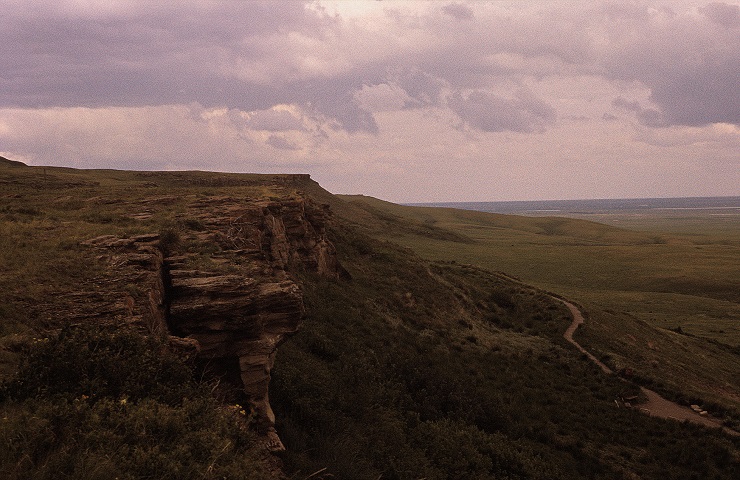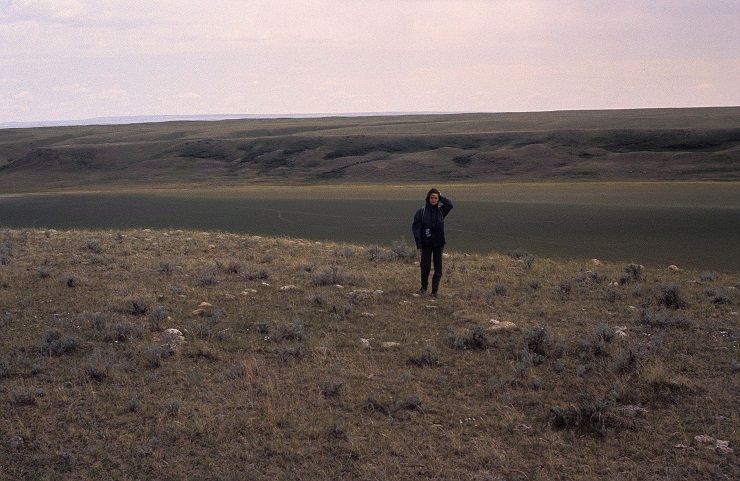The small and relatively inconspicuous Head-Smashed-In cliff that rises from the prairie located below the Canadian Rocky Mountains in Alberta has been used by humans since 3700 BC, i.e. for a period of nearly 6,000 years. This is one of many similar sites that are described as buffalo jumps. The populations that lived there seasonally and hunted bison belonged amongst the ancestors of today’s Northern Peigan Indians, who are associated with the Blackfoot Confederation. The original name of the cliff - estipah-skikikini-kots - can be loosely translated into English as “head-smash-in”. This name allegedly recalls the unfortunate fate of one Indian youngster who wanted to see the buffalo falling from the cliff and therefore he stood under it.
 |
| Although it is not very high the Head-Smashed-In cliff does dominate the landscape. Below it, just beneath the ground surface, stacked layers of bison bones that the Indians had hunted there for millennia were found. Photo by Petr Květina, Alberta, Canada 1998. |
This site is well documented ethnographically, historically and also archaeologically, which thereby provides a unique collection of information enabling the interpretation of the social and the economical status of ancient hunters. The most valuable of these historical reports is the information provided by Peter Fidler, an English explorer in the service of the Hudson Bay Company, who arrived in the area in 1792 and witnessed the hunt in Head-Smash-In personally.
The Blackfoot Indian way-of-life was based on mobility and thereby was well adapted both to the climate and to the available natural resources of the prairies. The basic social organisation consisted of not only of families but also of bands. These were relatively flexible groups of cca. 100-200 people living in a teepees. During the winter, these groups of Blackfoot Indians scattered and lived in protected valleys that also provided sufficient fuel, water and food. In summer and autumn the groups would merge into larger units for their traditional tribal ceremonies and communal hunting. These seasonal movements and gatherings of Indians had a strong association with the migration of buffalo herds.
Another such meeting place of several Indian bands was the Head-Smash-In rock overhang. This constituted a vast complex that covers an area of cca. 600 ha, the individual components of which were mutually functionally linked. The dominant feature at the site is a 300 m long cliff towards which stampeding buffalo were herded and then the animals fell down 35 m from the top of the cliff and then they were butchered. Other hunters immediately processed their dead bodies. The meat, the horns and the skin were separated from the bones and the bones were then broken for the purpose of obtaining the bone marrow. The intensive and challenging processing of the catch enabled securing a major part of the needs of the indigenous communities that had gathered and it was not only the meat that was used. The bones were processed to produce both tools and ornaments, while the skins were used for the manufacture of clothes, containers and other kinds of equipment.
 |
| Archaeological remains of Indian encampments on the Great Plains are frequently represented only by the stone circles that are used for anchoring the tent poles of the teepees. There is a photograph of one of these, with a dry riverbed visible in the background. Photo by Petr Květina, Alberta, Canada 1998. |
Want to learn more?
- Brink, J. 2008. Imagining Head-Smashed-In: Aboriginal buffalo hunting on the northern Plains. Edmonton: AU Press.
 Archeologické 3D virtuální muzeum
Archeologické 3D virtuální muzeum

.jpg)